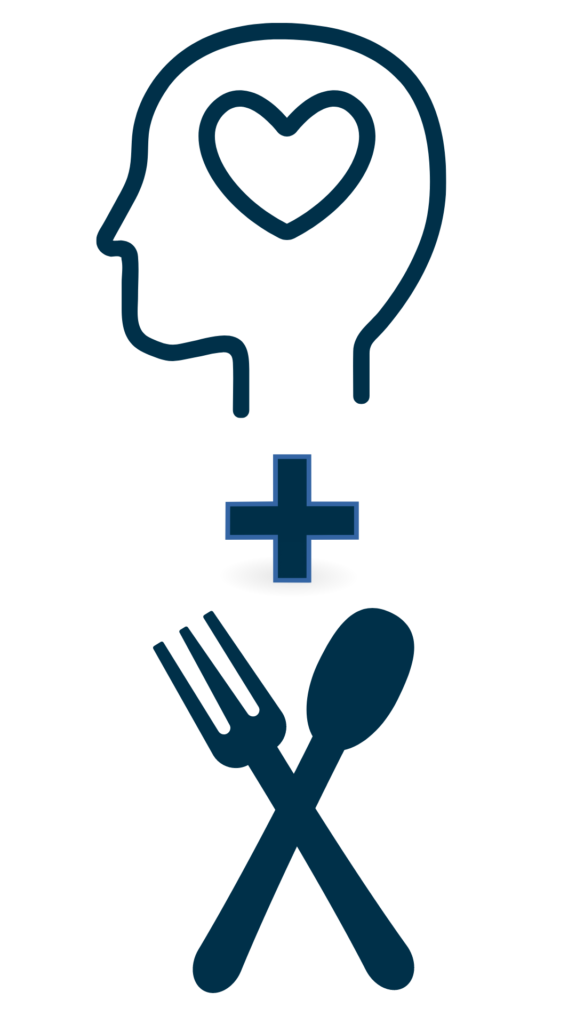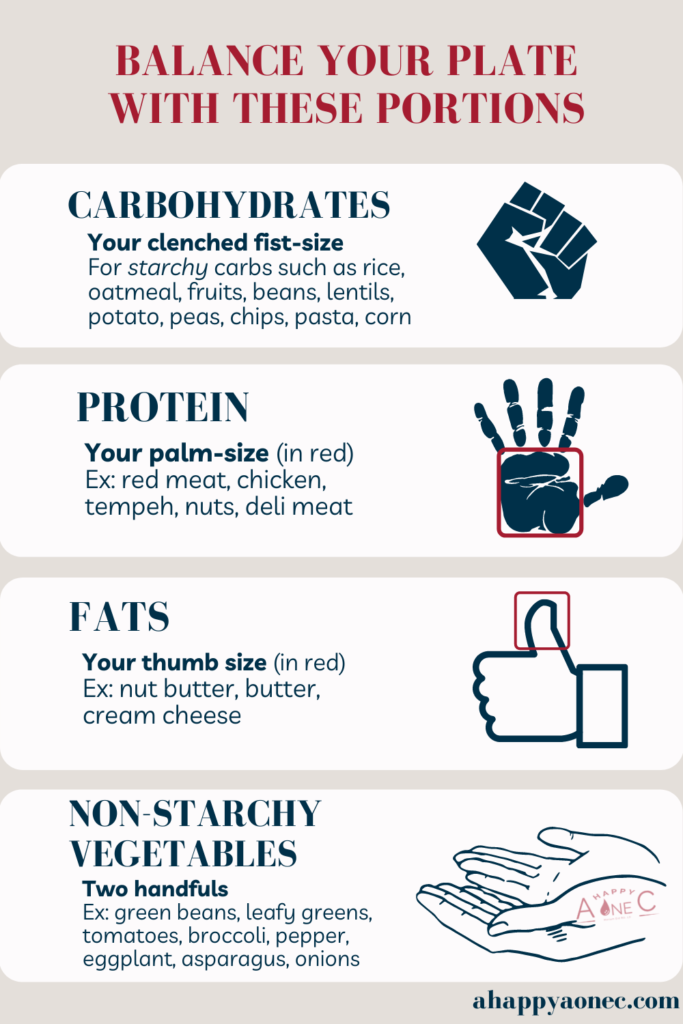It’s not about what you don’t eat, it’s how you eat it. In a previous article, we dove deeply into the first of two pillars to permanently reverse prediabetes. This article serves as a continuation of the previous article to provide you with a solid foundation on how to make food changes that are influential, manageable, and transformational. Mindset is a fundamental piece in this puzzle because the guidance discussed in this article becomes a way of life.

Reversing prediabetes requires having healthy mindset around food and your body AND understanding how to eat to feel your best. The principles outlined in this article are SO powerful in helping you get to know your body, identify how you function optimally and recognize how to eat to feel your best. This transforms your food and body literacy by allowing you to meet both your physical and emotional needs from food.
Since the nutrition guidelines in this articles are constructed around achieving blood sugar balance, they may also apply to people seeking general advice for health-promoting behaviors, controlling levels of inflammation, and/or prevention of chronic diseases.
The first question after a prediabetes diagnosis is often, what can I eat to reverse prediabetes? As a Registered Dietitian, I can confidently tell you that you can still enjoy the foods you love. Many people with prediabetes are under the false assumption that you must cut or restrict certain foods with prediabetes. “What” you eat implies there should be foods you should and should not eat. But reversing prediabetes is NOT about removing the “should not” foods — it’s about adding blood sugar buffers to them. So, how should you eat to reverse prediabetes? I’m so glad you asked.
To science-minded people, “reversing” a condition is often approached with skepticism. To be clear, there are things we can do now to lower your A1C and fasting blood sugar to prevent them from reaching the diabetes thresholds. The American Diabetes Association reports that 25% of people with an A1C of 5.5% to 6% will develop diabetes in 5 years. That same statistic suggests that 50% of people with A1C of 6% to 6.4% will develop diabetes within 5 years. Once prediabetes crosses into Type 2 Diabetes, all we can do is manage the condition — not reverse it. That’s why this prediabetes diagnosis is a turning point in your life. You have the power to reverse it before it progresses to Diabetes.

How to apply this article
The information in this article may seem overwhelming. You are NOT expected to apply everything listed in this article overnight. In fact, that will likely backfire and lead to health burnout. Instead, I encourage you to use this article as a starting point in your journey to reverse prediabetes for good.
At the end of this article, you will find examples of concrete recommendations listed. Select ONE small, realistic change that resonates with you most and focus on gradually adding it to your day-to-day life. Check-in with yourself every week to figure out how sustainable the change was for you. Once the change becomes second-nature to you, consider adding another one. The trend here is that you are gentle with yourself and take your life priorities into account. Visit this article to dive more deeply into reshifting your perspective around your health.
Fluids
With prediabetes, fluids are often one of the most overlooked areas. Believe it or not, if we’re dehydrated, our blood sugar reading can actually appear higher than normal. Therefore, before getting into the specifics around food and prediabetes, consider what you drink on a daily basis.
- How much water do you drink?
- What other fluids are a part of your routine?
Our bodies digest liquids much more quickly than solid foods because they take less mechanical work to be digested and broken down. At the same time, we are also VERY efficient at digesting and absorbing sugars. Therefore, if you drinking carbohydrates can quickly spike your blood sugar levels. This is why sugar-sweetened drinks can mess with your blood sugar levels more than any food option. This include any sweetened drinks, such as fruit juices, energy drinks, slurpees, sports drinks, sweet coffee or teas, or regular carbonated sodas.
Prediabetes increases your risk for dehydration because your body will try to lower your blood sugar levels as best it can. One of the ways to do that is to make your bladder more active causing you to pee more to get rid of excess sugar.
In a previous post we outlined that the goal with prediabetes is to control how quickly your blood sugar increases after eating. We do this to control the release of insulin and favor your blood sugar coming down at a steady rate. Since the sugars in a liquid form are not held back by fats, proteins or fibers, they flood your bloodstream with sugar, spiking your blood sugar and insulin levels.

Where to start?
There are many ways to approach your fluid intake but I would personally recommend starting with simply working up to drinking 8-10 (8 oz.) glasses of water, which is equal to about 4 regular 16 oz. water bottles. Check out this detailed article to decode the confusion around fluid intake and prediabetes.
the three food groups
why knowing your food groups is critical to reversing prediabetes
Before you continue, I HIGHLY suggest you review this article to learn about the blood sugar response to each food group and review the concept of carbohydrate pairing. This article will focus on enhancing your understanding of each macronutrient, their sources, recommended serving size, and discuss how they can be manipulated to balance your blood sugars. I encourage you to find foods you ALREADY know and love and brainstorm how you can eat them in a way that satisfies you and your blood sugars.
The goal of this article is to demonstrate that ALL food groups are important for prediabetes management. Every food group holds its own unique vitamin and mineral profile, making each one essential. It’s important to be confident in your understanding of food groups so that you can balance your meals AND blood sugar levels. This balance serves to increase your insulin sensitivity and achieve a happier A1C when you complete lab work again in 3 months.
To understand blood sugar balance, we must understand food groups. The three food groups (A.K.A macronutrients) are carbohydrates, proteins, and fats; they make up what we know as calories. Every food contains a unique ratio of each macronutrient. Each food group serves a purpose for our overall health and contains a specific profile of vitamins and minerals. Including all food groups is important for a well-rounded diet, balanced blood sugars, and prevention of vitamin and mineral deficiencies.
If you’re feeling a little spicy, try taking this quiz to identify how well your know your food groups. You can take it again after you’ve reviewed this article to compare your answers. If you have any questions about what food group(s) a certain food falls into, feel free to leave a comment below!
what are carbs?
Carbohydrates, or carbs, are one of three macronutrients needed to achieve a balanced diet. There are many types of carbohydrates, but they can be simplified into two: fibers and sugars. Fibers and sugars are processed uniquely by the body and serve opposing functions. To understand how they affect blood sugar levels, you must know that there’s a difference between digestion and absorption. Digestion simply refers to the breakdown of food by our digestive system. Absorption occurs when the digested foods officially crossover to enter the blood stream to be used by the cells in our bodies. Everything that is edible is digested but not everything that is edible is absorbed. Foods that are not absorbed continue along passed the absorption site and make their way into the toilet.
Sugar:
- Digested by the body AND absorbed into the blood
- Directly increases blood sugar levels because it’s digested quickly.
- Preferred fuel source for the body
- Provides satisfaction to our meals
- Referred to as “simple” sugars because the sugars are easy to digest, speeding up digestion and providing us with quick energy.
- Higher sugar (and lower fiber) carbs are quickly absorbed into the blood, causing the blood sugar to spike above normal levels.
- The spike leads to a dramatic fall in blood sugar, called a blood sugar crash, where the blood sugar levels call below normal levels. It’s accompanied with hunger, irritability, sleepiness, headaches, dizziness, and shakiness.
Fiber:
- Digested by the body but NOT absorbed into the blood
- Indirectly increases blood sugar levels because it slows down digestion.
- Exercises the digestive tract and eases bathroom trips
- Helps you stay fuller for longer periods of time.
- Referred to as “complex” or “slow-digesting” carbs because the fibers SLOW down the speed at which the other sugars in the food mix are absorbed into the blood.
- Higher fiber (and lower sugar) carbs are absorbed more slowly into the blood in the presence of fiber. This lowers the blood sugar peak and prevents both a blood sugar spike and crash.
- Promotes healthy gut bacteria by feeding the microbes that live in our large intestine.
- When adding fiber into your diet, make sure you drink enough water to prevent feeling constipated.
All carbs contain a unique ratio of sugars to fibers. There are different categories of carbohydrates, including grains, starchy vegetables, non-starchy vegetables, fruits, and fun foods/drinks. With prediabetes, we STILL need sugars in our meals to increase our blood sugar but the key lies in how quickly our blood sugar increases.
We need a steady, reliable dose of sugars entering the blood in a controlled manner at every meal to achieve healthy blood sugar levels, emotional satisfaction, and intake of the vitamins and minerals found in carbs. Of course, we can’t ignore that carbohydrates give us joy and satisfaction that can’t be replaced by other foods. So please, don’t try to replace your rice with cauliflower. It just won’t cut it.
Fiber holds many health benefits, including lowering cholesterol levels, balancing blood sugar, and enhancing fullness. Since fibers don’t get absorbed, they continue along the digestive tract to feed the gut bugs in our colon and promote regular bathroom habits. Non-starchy vegetables are technically carbohydrates but contain a high percentage of fiber compared to absorbable sugars. In other words, they don’t give us the quick energy or satisfaction that other carb sources do. Therefore, they are not considered an adequate carbohydrate source alone. They serve as a fantastic method to add extra fiber into your meal for blood sugar stability, especially if your carbohydrate choice was a lower fiber option.
"Good" vs "bad" carbs
Labeling carbs as “good” vs “bad” introduces black-and-white thinking around food. This absolute mindset encourages a restrictive approach around “bad” carbs, leading to more enhanced cravings and binge-like behaviors. It also proves detrimental to your relationship with food because it introduces guilt and shame when consuming “bad” carbs and incorrectly places moral value on food. Guilt and shame are reserved for immoral actions, such as lying, cheating, stealing, etc. The way we choose to eat has nothing to do with our character or moral compass. Therefore, I do NOT recommend this type of food labeling. To learn more about the harms of black and white thinking around food, visit this article.
The reason why carbs are often categorized as “good” versus “bad” is simply related to the way our blood sugar responds after consuming them. Higher-fiber, lower-sugar carbohydrates, such as whole grains and legumes, are deemed low-glycemic carbs and are considered “good” because the sugars are held back by the present fibers, which slows down the rate at which blood sugar levels increase. Lower-fiber, higher sugar carbohydrates, such as desserts, sodas, and refined grains, are deemed high-glycemic carbs and are considered “bad” because the sugars have a strong potential to spike blood sugar levels, leading to a blood sugar crash.
What are proteins & Fats?
Both fat and protein are critical for hormonal health, enhancing fullness, and balancing blood sugars. They are both send a strong fullness signal to the brain, but protein sends the strongest signal. Like fiber, fat and protein also lower the blood sugar peak to help with blood sugar balance.
Fiber, fat and protein are more complex to digest than simple sugars. Out of all three macronutrients, fats require the most work to be digested. Therefore, protein, fiber, and fats all slow down the speed of digestion, which allows the sugars digested with them at that meal to land more slowly and steadily into the bloodstream. As a result, protein, fat, and fiber help your body extend the energy it receives from sugars in carbs, allowing you to feel more energetic throughout the day.
In other words, fiber, fat, and protein serve as blood sugar buffers and promote blood sugar balance. If you would like to dive more deeply into blood sugar curves, check out this blog post.
In addition, protein is critical for immunity, muscle-building, cell structure while fats are critical for brain function, reproductive health, cell cushioning, and most importantly, flavor. All three food groups help us reach both physical and emotional satisfaction and work cohesively to balance blood sugar levels.

How Much Carbs, Proteins, and Fats Should I Eat?
Technically, one serving of carbohydrates is 15 grams. This measurement can be applied to a nutrition label under the “Total Carbohydrates” section. One MEAL should include 3-4 servings (45-60g) of cooked carbohydrates, which end up roughly the size of your fist. Despite what the internet says, carbohydrate counting is not necessary unless you have Type 1 Diabetes or advanced Type 2 diabetes.
The suggested portion sizes for each macronutrient is listed on the right. Although non-starchy vegetables are technically carbohydrates, they are portioned differently than regular, starchy carbohydrates because of their unique low sugar and high fiber content.
Although I included these measurements for reference, I advise against scientifically measuring the amount of foods you eat. Instead, you can use the post on the right to learn how to use your hand as a visual portion guide. The good news is that you can take your hand with you everywhere and practice this exercise even when eating out. You’ll also notice that serving sizes vary from person to person because we all have unique hand sizes.
NOTE: If you are someone with a history of eating disorders or disordered eating, please do NOT measure your foods and consult with your physician, therapist, and dietitian to identify your recommended course of action for portion sizes.

Balancing your plate
So, How Do I eat carbs?
To achieve blood sugar balance, balanced food choices need to be made. Balancing your plate includes adding all food groups to ensure you have adequate amounts of fiber, fat, and protein at all meals to stabilize your blood sugar, and lower your A1c in the long run. The blood sugar-lowering effects of fiber, fat, and protein allow you to eat the carbs you enjoy in a way that feels good for your body and your blood sugar numbers. Below we will outline how to approach meal planning with balance.
To get started with balancing your plate, you can use this order:
- Refer to the carb categories below to select a fist-size amount of your preferred carbohydrate.
- Choose a palm-sized amount of your protein of choice
- Prepare the protein using a thumb-sized amount of a fat base, such as butter or oil.
- Add a non-starchy vegetable for additional fiber.
CARB SOURCES
grains
- Rice
- Oats*
- Corn*
- Bread
- Ramen
- Tortilla
- Popcorn*
- Pasta
- Chips
- Bagels
- Cereals
- Barley*
- Quinoa*
- Crackers
- Pizza crust
- Pita Bread
- Sourdough
- Wild rice*
- Brown rice*
- Regular flour
- Corn flour tortilla*
- Whole wheat tortilla*
- Whole wheat bread*
- Bean-based pasta*
*whole grains or rich in fiber
Starchy veggies
- Peas
- Corn
- Lentils
- Sweet potato
- Potatoes
- Black beans
- Black eyed peas
- Red kidney beans
- Butternut squash
- Garbanzo beans or chickpeas
fruits
- Pear
- Plum
- Kiwi
- Apple
- Berries
- Apricot
- Banana
- Melons
- Mango
- Grapes
- Papaya
- Orange
- Pineapple
- Tomato
Non-Starchy veggies*
- Okra
- Artichoke
- Broccoli
- Cauliflower
- Cabbage
- Brussel sprouts
- Celery
- Cucumber
- Onions
- Garlic
- Raddish
- Mushroom
- Spinach
- Snap peas
- Green beans
- Peppers,
- Water chestnuts
- Peppers
- Radishes
- Leek
- Jicama
- Asparagus
- Swiss chard
- Eggplant
- Carrots
Other/Fun foods
- Milk
- Soda
- Syrup
- Honey
- Juices
- Slushies
- Cake
- Muffin
- Candy
- Cookies
- Chocolate
- Ice cream
- Flavored yogurt
**Non-starchy veggies are mostly fiber and NOT a significant carb source alone. Pair them with other carbs, such as a grain, beans, or starchy veggie to feel more energized and satisfied after eating.
Fat, Fiber, And protein Sources
Many foods overlap in both fat and protein sources, including milk, nuts, cheeses, eggs, meat, and chicken. There are also certain foods that overlap as a rich source in fiber and protein as well as fat and fiber. These overlapping foods typically have a more powerful effect on balancing blood sugar and serve as great snack choices. If you’re looking for more plate guidance, I recommend the American Diabetes Association’s visual demonstration. Below, you’ll find a Venn diagram outlining protein, fat, and fiber (PFF) sources to pair with your carbs so that your blood sugar levels respond in a more balanced manner. This layering method “PFFs” up your carbs and outlines the “how” behind eating carbs to reverse prediabetes.

What If I'm Still Hungry?
- Honor your hunger and go for another round of complex carbohydrates paired with fat and protein.
- Check your plate balance: make sure you included enough carbohydrates, fiber, protein and fat at your meal
- Practice mindful eating by chewing slowly and limiting distractions at meal times
fearing carbs
Many people are falsely told that the only way to reverse prediabetes is to cut out carbs. If you’ve cut out carbs before, I understand why you may be afraid to add them in again. You may be scared to over-consume them and lose control. Restricting carbs is not the answer.
We learned above that even sugars in carbs serve a biological purpose. This is precisely why anyone who has ever cut out carbs soon realizes that they develop intense cravings for them. We have a biological inclination towards carbs because they increase our blood sugar more efficiently than any other food group. Foods like cakes, cookies, chips, chocolate, and brownies provide emotional satisfaction. The mystery why you may feel a loss of control with carbs is rooted in that they aren’t very filling.
These delicious foods lack fiber, fat and protein, which ALL send strong fullness signals. Therefore, we can PFF Up these “fear” foods in a complementary fashion such that you retain the emotional satisfaction of the meal while achieving physical satisfaction. My favorite way to layer up salty carbs, such as chips and crackers, is to pair them with cheeses or a bean dip. Below, you’ll learn more on how to PFF Up sweeter carb choices.
This realization is empowering because it allows you to recognize that you are not “powerless” in front of these foods. Instead, you simply needed the skills and tools to create a balanced food choice. This strips the power from them and redirects it to you. This is a pivotal step in building your nutrition knowledge base so that you balance your blood sugar, lower your A1C, and achieve a happy relationship with food.
How to Enjoy Sweets
Quench your sweet tooth. All foods can fit into a balanced diet. The main idea with approaching desserts is HOW you approach them. Sweets serve have a place in a balanced diet and serve to emotionally satisfy us. However, you may have noticed that they usually aren’t physically satiating. We know that desserts are typically lower in fat and protein, which is why they aren’t physically filling. That’s why we cant rely on them to fill us up when we’re hungry. Instead, make sure you have a balanced meal with fiber, fat and protein to physically satisfy you first and follow it with the dessert of your choice to achieve both physical and emotional gratification.
You’ve probably noticed by now, the name of the game with eating carbs with confidence is pairing it with fiber, fat, and protein. But, of course, chicken doesn’t exactly complement a cookie. That’s why I encourage you to add nuts and nut butter varieties to your desserts or eat them alongside your cookie or chocolate bar. You can also explore my personal favorites on this page.
If you don’t feel like having anything with it, you can also opt for simply moving around after enjoying it mindfully as opposed to remaining seated or sedentary.
This feels like too much
That’s because it is too much. As I mentioned earlier, these changes don’t happen overnight. Working with a registered dietitian can provide you with more structure, accountability, and resources to navigate this very confusing process.
As a starting point, I encourage you to use the flow I’ve laid out below to help you make more sustainable behavior changes for your health and the reversal of prediabetes. Start with the principle that speaks to you the most. Check-in with yourself every week to see how sustainable it is for you. Give yourself at least a month to nail down one goal before adding another one. I highly recommend that you bookmark this article so that you can use it as a reference point throughout your wellness journey.
- Work up to drinking at least 8, 8 oz. glasses of water or 4, 16 oz. bottles dispersed evenly throughout the day. Build up in one-glass increments every 2-3 weeks.
- Intentionally plan to eat 3 meals and 1-2 snacks per day and avoid skipping meals. Build up in one-meal or snack increments every 2-3 weeks.
- Avoid relying on desserts and sugar-sweetened drinks to fill you up when you’re hungry. Instead, always have them with or after a balanced meal.
- Control your intake of sugar-sweetened beverage by finding alternatives that satisfy you.
- Pair your carb choices with fat, fiber, and protein at every snack. Start with choosing a carb and pair it with at least a protein source. Once you’re comfortable with this combination, work your way up to gradually adding more fiber and fats.
- Choose a fiber-rich carbohydrate, such as a starchy veggies, beans, or whole grains, outlined above for your dinner meal.
- Build up to creating a balanced plate at every meal as outlined above, starting with a carbohydrate paired with a protein source.
- Continue to build your balanced plate by adding fats to your carbohydrate and protein source.
- Explore different non-starchy vegetables as a means of adding more fiber to your dinner meal. Experiment with ONE non-starchy veggie outlined above and try preparing it several ways before declaring that you don’t like it. Get creative and research air-frying, roasting, and grilling veggies with different seasoning blends to identify your personal textural and taste preferences with it. Everyone is on their own “veggie” journey is lifelong. If you already have a veggie you know you like, stretch from the familiar and vegetable similar in taste or texture to explore. For example, if you like carrots, try bell peppers. My biggest piece of advice is, don’t judge a vegetable before it’s well-seasoned and textured to your taste.
- Build a balanced plate at every meal with complex carbohydrates, proteins, fats, and a non-starchy vegetables.
The Takeaway Message
Your health is a marathon NOT a sprint. The goals discussed in this article can take YEARS to implement. PLEASE know that this is a long-term project. Delete the all-or-nothing mindset — it’s the AVERAGE of your intake and behaviors that truly matter rather than one particular day or meal. We don’t receive guilt or shame at A Happy AOneC. Instead, we CELEBRATE small, realistic goals. These incremental changes are key to developing long-lasting habits you can carry with you lifelong and pass down to your children. Your future self will thank you.
